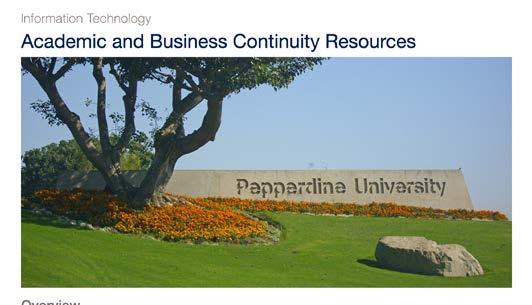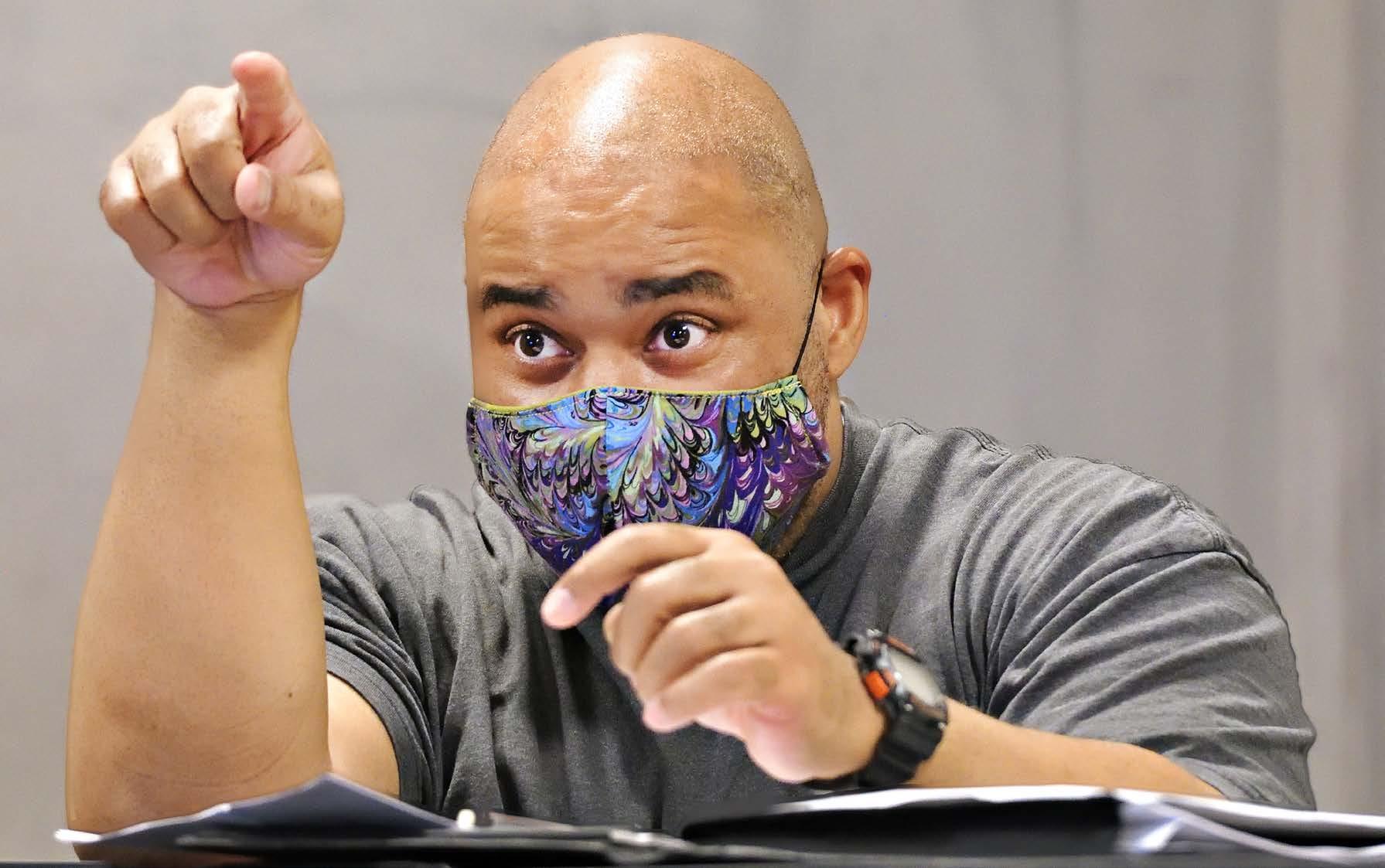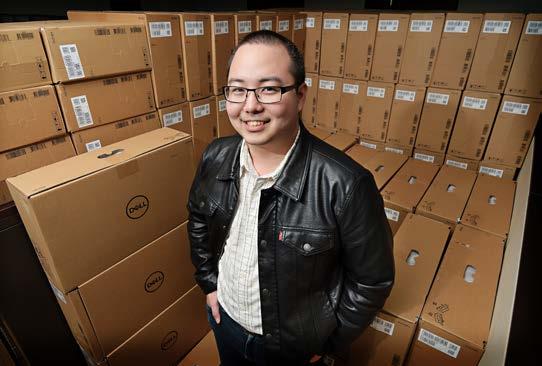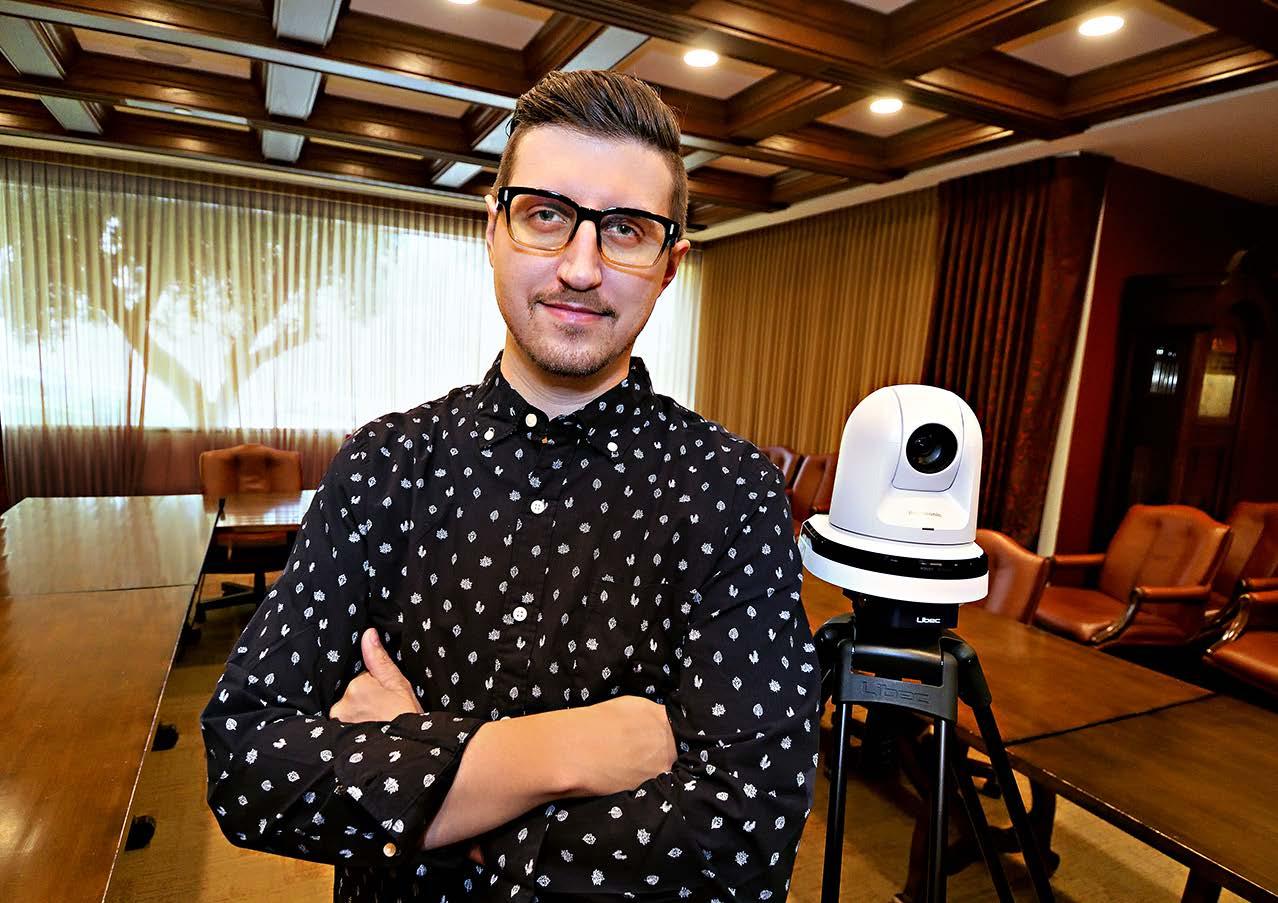
13 minute read
The Dawn of Remote Reality
“What a difference a year makes,” said Senior Director of IT Administration and Client Services Gerard Flynn, remembering where he was in late February 2020. “It was a Saturday...February 29,” he continued, “and I was flying to Seattle for the ELI Conference (EDUCAUSE Learning Initiative). I had intended on hosting faculty representatives from several of Pepperdine’s schools as well as our Technology & Learning department.
“Then, in the course of 48 hours, news broke that the region had experienced significant Coronavirus outbreaks in the area, primarily at nursing homes,” Flynn continued. “Some faculty who were going to join us decided against attending when they heard the story.”
Other Pepperdine staff made it to LAX before being notified, and one TechLearn staff member got as far as the lobby of his Seattle hotel before doing an about-face and coming home to Los Angeles.
“Dr. Charla Griffy-Brown is a professor in the Graziadio Business School, and she lives in the Seattle area,” Flynn noted. “She graciously invited a couple of us to her home for dinner, and her family was already talking about school being cancelled locally, with the possibility of remote study. Then the conversation shifted to having the kids study from home, and we talked about how to make that happen.”
For Pepperdine, it happened quickly.
With the Shanghai program already closed due to COVID-19 on January 28, and the Florence program suspended on February 26, the virus was spreading quickly abroad. Less than a week later, the University suspended the Heidelberg and Lausanne international programs on March 1, followed by the London and Buenos Aires programs on March 10.
“Roughly a week after coming back from Seattle, when the other dominos fell, it seemed to be an international affair,” Flynn noted. “Then on March 11, President Gash issued an announcement that Pepperdine would be having remote classes for the remainder of the semester for all our domestic campuses. So, the last day of in-person classes was March 13.”
As a major university with five Southern California campuses, Washington, D.C., and the aforementioned International Program sites, there were operational and technical chasms between functioning as an in-person institution and switching to emergency remote instruction in just a few days. Bridging that gap would require a fundamentally different approach to teaching, learning, and working that hinged on multiple variables.
“Prior to these events, the IT department, including IT Communications, the support teams, and the training teams, was working very hard to communicate, to train, and to develop a plan to support the students, faculty, and staff at these international campuses because they would have unique needs this year,” Flynn said. Above, Lead Instructional Technologist Natalina Parker started her days at 4:30 AM to accommodate the Seaver International Programs faculty and staff.
“For example, we initially published a webpage to inform Seaver students in the Florence program on how to obtain resources and to study in this new environment,” Flynn explained. “And as these other International Programs suspended their operations, we adjusted our web content to direct people to our training resources and support avenues for all programs.”
In the two weeks from the Florence campus closure to going fully remote with all classes, Pepperdine University successfully pivoted its entire pedagogy to distance learning.
“The different programs started to shift one by one in late February, with Shanghai being hit first,” said Director of Client Services Alan Regan. “But the bigger one was when all of the European programs went online. Natalina Parker from our Technology & Learning team immediately went to work with International Programs to schedule times that were early in the morning so that the time difference could work out for those faculty members abroad.”
or example, we initially published a webpage to inform Seaver students in the Florence program on how to obtain resources and to study in this new environment,” Flynn explained. “And as these other International Programs suspended their operations, we adjusted our web content to direct people to our training resources and support avenues for all
In the two weeks from the Florence campus closure to going fully remote with all classes, Pepperdine University successfully pivoted its entire pedagogy
“The different programs started to shift one by one in late February, with Shanghai being hit first,” said Director of Client Services Alan Regan. “But the bigger one was when all of the European programs went online. Natalina Parker from our Technology & Learning team immediately went to work with International Programs to schedule times that were early in the morning so that the time difference could work out for those faculty
We let everyone know that they were supported, and that they were not alone. ”
“I remember it very well,” said Lead Instructional Technologist Parker. “It was a week before the campus shut down, and we did an orientation with “I would be lost without all this instruction and In short order, Cisco Jabber, Google Shared Drives, and Zoom became the language of how the University functioned every day, as students embraced remote 10 to 12 people at 6 AM. We had three or four group consultations with them. And then moving forward, I worked with Lausanne which was a little more intensive. “They scheduled several training sessions with the faculty in Switzerland,” support. I also enjoyed being able to work with Pepperdine learning, one day at a time. “This was impressive, not only from a logistical perspective, but also because it provided Pepperdine with the opportunity to embrace the (remote) technologies as a community,” said Regan. “It also gives us a Parker continued, “and I created a course template so that they could go in and apply colleagues from lot of flexibility for accessibility of classes and content.” their content. So, rather than having to build out modules, they had a template that they were able to use that allowed them to add learning objectives, links for videos and readings, and any other material they wanted to include. That was all different campuses and specialties.” The Technology & Learning group (TechLearn) was essential in working with Pepperdine faculty in creating a structure to move their courses online, but that was just the beginning. really helpful for them.” “Those teams immediately added a A number of teams were vital in working long hours in designing resources, training programs, and communicating their availability to all faculty, staff, and students. The IT department worked to Melissa Huy, PhD Visiting Clinical Professor GSEP significant number of classes to the schedule including crash courses in Zoom basics and more advanced details on how to use the Gradebook, Forums, and Tests and Quizzes tools in our LMS, Courses,” said Regan. provide resources for traditional office staff Based on their comfort level with members, for example, who found themselves working from home. technology, some training session attendees were more stressed as IT had to answer basic questions including: they coped with the changes that came with remote instruction. • How do you answer your office number? “We let everyone know that they were supported and that • How do you share files? they were not alone,” Regan noted. “At times, that support also came from peers, as Pepperdine’s faculty and staff would pitch in • How do you conduct business? during Zoom meetings, sharing what works along with alternate • How are you holding virtual meetings? strategies, tools, and ideas.”
2020: THE YEAR THAT WENT VIRAL
January 28, 2020 February 28, 2020 March 2, 2020 March 13, 2020
COVID-19 concerns lead Pepperdine to suspend the Shanghai program. Two days after Pepperdine suspends the Florence program, IT launches its Coronavirus resources page. The day after the Heidelberg and Lausanne programs suspend, TechLearn begins trainings for Seaver International Programs faculty and staff. • Pepperdine University suspends all inperson classes for all remaining campuses. • TechLearn launches daily “remote teaching” training series for all faculty.


28 28 2 13

There were also countless emails to IT Training and TechLearn with everything from general questions about Zoom to specific technical support issues. As IT Training and TechLearn Manager Jordan Lott noted, the quick transition to remote teaching and learning required considerable support.
“Sudden increased usage means sudden increased questions as well,” Lott observed. “We had to ramp up support very, very quickly, from building and conducting new trainings, to answering questions from everyone. IT Training also created increased office hours so that people could book an hour to ask questions one on one.” Above, Lead Client Technology Analyst Bronson Somerville offered technical direction.
Lott worked to create greater dexterity within the two teams to provide greater coverage summer and fall terms look like at Pepperdine? How long would for the community’s support needs. it take to recover from the pandemic? Upgrading the University’s “IT Training has more of a group-style environment, while TechLearn often uses more of a one-on-one style approach,” Lott classrooms with the necessary technology to deliver hybrid learning became IT’s top priority. said. “In response to the community’s increased support demand, “When it became obvious that this was a longer, more both teams recognized that that one method isn’t better than the substantive challenge with a longer timeline,” Flynn noted, other. So, each team started offering more of what they typically “President Gash and the Deans asked the AVT department to didn’t do. IT Training was offering one-on-one sessions, while investigate designing classrooms to deliver hybrid instruction.” TechLearn offered multiple group sessions every week.” “I try to be as proactive as possible,” said Manager of Audio-
These collective efforts focused on the community’s immediate Visual Technologies (AVT) and Special Projects Jared Mukai. “And needs as campuses suspended in-person classes, but the IT I think that’s one of the things that we really tried to do over the last department also recognized an even bigger potential hurdle on the few years is to get away from being reactive to everything and really horizon. Thinking past the spring semester, what would the focus on preventive measures.

March 16, 2020 April 15, 2020 June 2, 2020 August 7, 2020
IT Training launches “remote working” training series for all staff. The classroom refresh project kicks off with a goal to complete audio-visual equipment upgrades that would normally take 10 years to complete. New AV equipment begins arriving at Pepperdine’s Malibu campus.


16 15 2

Just 70 days after the first equipment arrived in Malibu, and less than four months from the project’s inception, the Audio Visual Technologies group verifies that 166 classrooms have been refreshed to accomodate hybrid teaching. 7
I just want to send a huge thank you for your ongoing and prompt support for my technical needs during online instruction. ”
Ellie Tabibian
Adjunct Faculty GSEP
“About five years ago, we set up our AV Refresh Program where we try to put all of our 200 classrooms on a five-year cycle,” Mukai explained. “So, we try to refresh about 20 percent of our rooms every year, and 2019 concluded that first five-year cycle.
“We were looking forward to all the new technologies we could install while re-evaluating what the new standard was going to be,” Mukai said. “And of course, COVID threw a big fat wrench into all of that. “We also had to think forward and assume that this might not go away anytime soon,” Mukai added. “Yet, at the time, we had no idea what it was going to be like in the fall semester. Were we going to be able to have students on campus? Were we going to be able to have in-person learning? Would it be fully remote? Would it be this weird hybrid, or maybe we don’t have max capacity, and only 50 percent of students can be on ground? We had to come up with several different solutions.”
“Lucky for us, we had more of the ‘make it happen’ freedom to do what we needed to,” said Audio Visual Technologies Team Lead Sean Kalaras. “We still had the challenge of looking down the road to make decisions on the best approach to build on what we already had in order to deliver the best result.”
The team understood that the solution would have to satisfy a number of requirements. Although the budget hurdle was removed early on, they still needed adaptability to the University’s existing classrooms and technology. And there was another issue that made time and timing crucial to the success of the project.
“Remember, COVID has suddenly put every other college, university, and business in the world in the same position with the same needs,” Flynn added. “So, now we’re all looking to buy the same equipment at the same time with the same sense of urgency,” Flynn added.
“Bronson Somerville is one of our Lead Client Technologies Analysts who supports the Business Division of Seaver College,” Flynn explained. “He saw the future last spring and immediately started ordering microphones and cameras to support Zoom sessions for his faculty.”
From one analyst’s instincts to AVT’s vision, the IT staff were preparing Pepperdine for what was to come.
“We worked with University leadership to determine the project scope,” said Mukai. “Pepperdine has five different (Southern California) campuses and five different schools that operate at those campuses, so we had to get all of their input on which rooms were the most important, which rooms would benefit from this technology, and which rooms weren’t going to be used during this time.”
With a scope, a budget, and an approved technical solution, the classroom refresh project launched on the main campus on June 2, 2020.
“We had three or four teams working in parallel at various campuses,” Mukai added. “At one point, we were knocking out 8 to 12 rooms a day. The pace we were working at was just remarkable. We transformed 166 classrooms to be longdistance-learning, hybrid classrooms.”
Ultimately, the massive project was completed in just 70 days over the summer, culminating on August 7.

Above, Audio Visual Technologies Team Lead Sean Kalaras in the TAC 100 conference room with a new Panasonic PTZ camera.

Above, Lead Client Technologies Analyst Jordan Seah conducts a training on the new classroom technology for the IT department’s Seaver Tech Liaisons in Malibu in July 2020.
“The scope of this project was 10 times our previously largest project and was completed in less than half the time,” said Flynn. “In retrospect, we achieved a tremendous amount of work. What I’m very pleased with, proud of, and grateful for, was the selfless work by all my IT colleagues.”
“We were ready in so many aspects, including the things people don’t even think about,” Regan added. “For example, the network team had an infrastructure in place so that, even when we’re at a skeletal crew, ‘The Show Must Go On’, and the show did. We were well-positioned by just good, old-fashioned contingency and project planning.
“With a TechLearn team of basically four people and an IT Training team of two, we helped thousands of people,” Regan said. “It just shows how small teams can make a huge impact in helping professors teach, students learn, and staff members work.
“That’s what I love about Pepperdine. It’s more than just its physical campuses: it’s about people, especially our amazing faculty. We’re all working together to create the best possible learning experiences to help our students become their best possible selves.”




